|
FAQs on the Hydrozoan Identification
1
Related Articles: Hydrozoans, Cnidarians, Fire Corals, Stylasterines, Hydrozoan Jellies,
Related FAQs: Hydrozoan ID 2, Hydrozoan ID 3, Hydrozoan ID 4, Hydrozoan ID 5, Hydrozoan ID 6, Hydrozoan ID 7, Hydrozoan ID 8, & Hydrozoans 1, Hydrozoans 2, Hydrozoan Behavior, Hydrozoan Compatibility, Hydrozoan Selection, Hydrozoan Systems, Hydrozoan Feeding, Hydrozoan Disease, Hydrozoan Reproduction,
Medusoids/Jellies (Ctenophores, some Hydrozoans,
Scyphozoans): Jelly Identification, Jelly Behavior, Jelly Compatibility, Jelly Selection, Jelly Systems, Jelly Feeding, Jelly Disease, Jelly Reproduction, Fire Corals,
Lace
Corals, Stinging-celled
Animals
|

|
| Strange Little Creature Hi All I have
recently setup a marine aquarium and spent a lot of time
researching the do's and don'ts! I have a 250L aquarium
with Eheim Wet/Dry Filter, Red Sea Turbo Skimmer, and Internal
Jewel Mechanical/Chemical Filter (which I want to replace for an
external). The tank currently holds 30Kgs of uncured live rock
which over the last 4 weeks has gone from looking quite sad to very
happy indeed! and a further 20kgs of crushed CaribSea sand and
shells. I still have a few weeks to go though before any livestock
can go in but my ammonia is 0 and my nitrate is now 0.3mg/l. There
are lots of critters which I have been able to identify but one in
particular has got me, please could you see if you know what he is?
He is living on the glass amongst the diatoms which have started to
appear everywhere, should these diatoms be left alone until I put a
cleanup crew in? <I would clean the diatoms off the glass.
That creature could possibly be a hydroid, something you really
don't want in the tank. To be safe, I'd squish him. James
(Salty Dog)> |
|
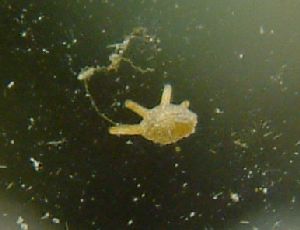
|
Lettuce sponge with feathers? Hi Bob! <Hello there> I
have searched and searched through this web site but could not find
anything similar to this problem... I have had an orange lettuce sponge
in my reef tank for about 3 months now. It has been doing fine, but a
few weeks after I got it, I started noticing a red feathery type of
growth on it. The "feathers" continue to spread and grow
larger, and I have no idea what this is. Is it a type of harmful algae,
or just a natural part of this sponge? A turbo snail wandered onto it
once and ate most of it off, but it just grew back. Any ideas?
<Likely some type of hydroid. See here:
http://www.wetwebmedia.com/cnidaria.htm I might leave all
alone... but am inclined to mention that if your sponge seems to be
suffering from this growth, I might "snip" it off... with
sharp scissors... with part of the sponge where it's attached...
and siphon/vacuum out as much of the material as you can after. Bob
Fenner> Laura
| "Who was that masked man?" [Cnidarian
ID] Right below the arm of the Atlantic gorgonian octocoral are
some very fine anemone-looking creatures. I'm not
sure if you can tell from the picture, but they do not appear to be
Aiptasia. Instead, it looks like they are growing from
very fine tubes. In any event, it looks as if they are
causing the polyps on the octocoral to retract. Are
these tube anemones? Are they (otherwise) desirable?
thanks tom <they are hydroids, Tom... a great nuisance...
prolific and will burn many desirable corals and other creatures.
Manually remove and be careful that overfeeding or messy feeding
habits are not the cause of their current or future growth. Best
regards, Anthony> |
|
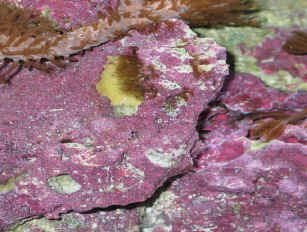
|
Unidentified Critters... stranded hydroids 6/9/04 I have had
a 30 gal reef tank for about a month now. I have 45 pounds
of live rock and 3 corals so far. Also some snails, hermit
crabs, a sand star and a blood shrimp. No fish yet. I have
been diligently checking chemical balances and everything seems on
target. In the past few days I've noticed some unusual
critters appearing on the glass and live rock. I've seen
several very small snails (1/32 inch) which began appearing before I
introduced snails into the tank, so I assume they've come from the
LR. <yes... indeed> In the past week I've noticed several
translucent critters on the glass which move like snails, have no
shells, are about 1/8 inch long and have 2 points at their back end.
<sounds like a flatworm... the little milky white ones prey on
copepods. All are harmless> From reviewing other questions responses
you've given, I've identified them as flat worms which are not
harmful. <Ah, BINGO- you win the hairy kewpie doll! Very
glad to hear you in the archives :) > However yesterday I've
noticed a new critter which, in reviewing your Q&A's, I cannot
identify. These seem to have emerged within the past
day. They appear to be long white strands with a single row
of "hair" (1/16-1/8 inches long) on one side. (Almost like a
1 sided long skinny white feather.) <Yikes... I
recognize it already. It is a very distinct description. Your creature
is a fiercely stinging hydroid. Do remove it... it will sting you and
your animals alike> They seem to be about 2-4 inches long and appear
to emerge from a jelly like polyp on the rock. They drift with the
current from my power-head, and periodically retract back into the
polyp. I assume that they are "netting"
micro-organisms, then "reeling them in" to be consumed. These
strands are so thin that they are not visible unless you are very close
to the glass. Any idea what these things are? Are
they dangerous to the other life in the tank? <yes... do be careful.
Best of luck, Anthony>
Ref: invert ref guide-j. sprung. Myrionema/stinging
hydroid. i was quite pleased with them until i found out they are
pests. now i feel like i was bragging about a tank full of anemones!
Aahh, oh well. all blissful ignorance must come to an end at some time.
<Embrace the change. Bob Fenner>
| Brown pom poms: hydroid ID 3/17/04 please
identify these brown pom pom like polyps that are growing on my LR
with my yellow stars. They are spreading and having a hard time
getting rid of them. <they are the nuisance hydroid Myrionema
and they can be a serious problem> I have been trying to rub
them off with my fingers and they come back quickly. <Yikes!
touch nothing in the tank with bare hands/fingers my friend! We
have seen/written about (see archives) folks get seriously
injured/ill this way. Piscine tuberculosis, Vibrio infections,
etc> Please tell me the best way to get rid of them. See
attached photo. thanks Ron <use the genus name provided above to
do a keyword search of our archives (Google tool at bottom of our
homepage) and beyond on the internet. Best regards,
Anthony> |
|
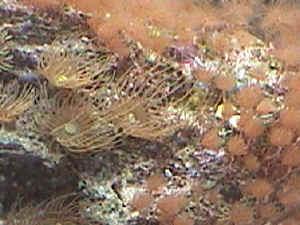
|
| Bad boyz- hydroids 12/30/03 Hi guys
<howdy> Can you please identify these "creatures",
they are about a quarter of an inch long and have a
"coil" at their base. I'm also not sure about the
green bubbles. Are either of these a problem? <the tube-like
critters are stinging hydroids and the bubbles are a Valonia type
algae or Halicystis stage of Derbesia hair algae. All are pests. Do
read through our archives of articles and FAQs for the (nutrient)
control of such organisms> <best of luck my friend.
Anthony> |
|
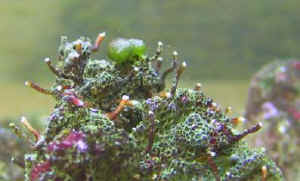
|
Unknown animal, invertebrate, probably hydroid About myself:
for the past twenty-five years I have been a developer of advanced
performance materials and only recently started to maintain marine
tanks. I have always been fascinated by the marine environment but in
the past mostly enjoyed it from a canoe (frequently at night) on the
Chesapeake Bay and the Albemarle Sound. <interesting... and are you
a member of the excellent local aquarium society, CMAS? Do look them
up.. great club.> About my tank: the tank in question is a refugium
that I could never bring myself to hook up its main tank. It was too
fascinating to risk ruining. It is 20 g with Inland Aquatics
detritivore and refugium flora kits 20lbs live sand and 10lbs live rock
(one piece) 2x65W 6500K PC lights, no filter or skimmer - just a single
airstone. After Hurricane Isabel, it went 6 days without any lights or
aeration (we had no power). Only obvious loss of life was one very
small snail. Upon return of power there was a slight cloudiness that
immediately cleared and was followed by a slowly worsening algal storm
that grew day by day until visibility was only a few centimeters. Much
of my macroalgae died and my copepods began to disappear. At the same
time a new animal began to appear in increasing numbers. Here is a
snapshot of it: <a Cnidarian... looks like/is likely to be a hydroid
IMO> It was about 1 cm in diameter and appeared to me to be some
kind of hydroid larva. <agreed... not uncommon> The algal storm
finally cleared and simultaneously the mystery larva disappeared. I now
have thriving copepod swarms and a goodish bit of Cyanobacteria on the
substrate. <increase water flow and protein skimming to eradicate
this Cyano> My son and I have looked hopefully for some polyps to
appear. We are quite excited by the prospect of finding the adult
animal. But so far we have not seen anything new. My question: What is
the mystery larva? Where did it come from? Where has it gone? <about
all I can say for sure is that larvae/medusae were likely carried in
with some recent addition (water from a wild source, on the shells of
Astraea snails, in bag water from another aquarium with shared
livestock that was not (properly) quarantined by you, etc> What was
its relation to the anoxic period, the algal storm and the copepod
population changes? What kind of adult animal can we hope to find? and
what should we look for? <time will reveal> I have feed the tank
regularly with shrimp pellets waiting until previous offerings have
disappeared. Right before the algal storm, and perhaps causing the
storm, I fed with two Spirulina tablets that took weeks to disappear
and only after they disappeared did the storm begin to clear. During
the storm I did not feed because I was waiting for the tablets to be
consumed. With such a heavy storm I felt that there was no lack of
nutrients to worry about. After the storm cleared, I resumed feeding
with shrimp pellets and weekly inoculations of DT. The water has since
remained clear. I test regularly, but the water parameters are always
perfect: Ca-400ppm, Total alkalinity-4.5meq/l. No measurable nitrate on
a reliable nitrate test. <do allow some nitrites (5ppm) if you will
keep corals successfully long term> Phosphate is low. I got these
results even during the algal storm! I thought some mineral parameter
must be off, but I guess that the nutrients must have been bound in
organic molecules and not detected by the tests. Of all my tanks, this
tank has, by far, the best test values. Also, there is no erosion of
the live rock which I see in the other tanks even though I work hard to
maintain calcium, magnesium and total alkalinity in those tanks. I have
never needed to add any mineral supplement to this tank because the
tests have always shown ideal values. (I suspect that the erosion of
live rocks in the other tanks is associated with the use of calcium
chloride in most calcium supplements. I have been experimenting widely
with calcium supplements and I am not happy yet with anything that I
have tried). <I strongly advise the daily use of calcium hydroxide
with or without a calcium reactor. It is tried and try and has many
benefits over other means of delivering calcium> I suspect that I
tend and feed the tanks rather than the livestock. I don't have
many fish: 7 in my 75 gallon and 2 in my 125 gallon. I am fascinated by
the water and all the complex interactions between its inhabitants that
it is my privilege to observe. I seldom intervene in the tanks except
to try to provide stable conditions, light and a modicum of food. I am
very interested in the zooplankton populations and have been toying
with the idea of harvesting plankton from the Chesapeake Bay and adding
them to one of my tanks. At night, when I go canoeing, that are
beautiful displays of phosphorescent plankton and medusa. <yes... a
marvel> I encounter them in small patches. Some patches are blue and
some are green and seem to phosphoresce in response to being disturbed
by the canoe. I would love to capture some of these and see what
happens when they are placed in a tank. It is probably a crazy idea.
<some are toxic as you may know... do be careful here> I
don't know what animals I would be introducing, what their
life-cycle would be, or what impact it could have on my tank. I would
appreciate any warnings or suggestions for reducing risk that you might
care to share. <all can/will be screened by the proper use of
quarantine tanks for all things wet coming in... corals, fishes,
snails, algae, live rock, etc... everything please> Thanks for your
attention. I have really enjoyed reading the articles and FAQs. They
seem very factual and have proven quite reliable. Karl <thanks
kindly... wishing you the best. Anthony><<RMF lost the pic...
pls re-send if you see this. Bob>>
| Brown Hydroid Myrionema 11/17/03 Hi! I was
wondering if you could tell me what is growing on this rock with my
yellow Stars? See attached photo. <it is a fairly common
nuisance hydroid, Myrionema... somewhat handsome looking to me, but
is admittedly a problem... can be a plague. They will sting corals
and clams and are invasive as you have noticed> They are
spreading very fast. At first I thought they might the yellow stars
just multiplying but they are brownish in color instead of yellow.
Please let me know what you think. thanks Anj <alas, we are not
aware of anything that consumes them yet (surely some organism(s)
does/do). Manual extraction will be necessary and be mindful of not
overfeeding the display which can fuel their growth.
Anthony> |
|
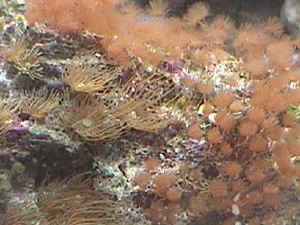
|
Hydroid hitchhikers 7/15/03 Thanks Anthony. The crab in
question finally came out of the rock work again and I fished him out
to take a closer look. Since I have the option, what do you recommend,
keep hydroids out of the tank or put them back in? <in a big enough
reef tank, I'd leave them in. Good water quality and they are
unlikely to flourish> The ones on that crab seem to be the only
colony. As for Aiptasia, I have had three very small ones that I first
noticed about a month ago. They haven't got much bigger in that
time and they certainly have not increased to plague proportions as I
have read others report. < a good sign indeed. A well managed
aquarium can have them in the display for years with little
reproduction. Its all about nutrient control> However, I am almost
to the point where I want to start stocking with inverts in earnest.
Shall I remove rock and nuke them while I still have the chance or is
good water quality enough to avoid problems later? <its enough...
but then again, most people overfeed or overstock in time. Do remove
the Aiptasia to play it safe. And be sure to QT all new inverts, rock,
sand in the future to prevent such critters from coming into the
display> By the way, my LFS has several rather large Aiptasia in
their tanks. Should one always avoid buying out of tanks like that?
<heck no! good husbandry means QT at home. You can screen most
anything from there.> Finally, if you would be so kind as to offer a
personal opinion. In general, would you expect the dual 6"
skimmers driven with Rio 600RV's found on the CPR CY294 to do the
job for a 170 gallon tank? <I think CPR skimmers can be tuned to
work very well... but are not so low maintenance or effective as
EuroReef's (idiot-proof and excellent). Aqua C skimmers instead are
one of the very best values. Two I would put ahead of CPR skimmers>
I expect to focus on inverts and lightly stock with fish. After running
the tank for 2 months and with only a couple of LPS and a half a dozen
small fish (5 Blue-green Chromis and a Sailfin Tang) plus a full
complement of snails and crabs, the skimmer throats are thoroughly
coated every day but I get very little liquid in the collection cups.
Is that what you would expect with a light bio-load or should I be
trying to produce more skimmate even if it looks a little on the pale
side. This is my first aquarium, and I have no reference point for
comparison. Regards. <no worries. Best regards, Anthony>
| Hermit crab hitchhikers: Hydroids - 7/14/03
What's this growing on the hermit crab's shell? Please
don't tell me it's Aiptasia. <no worries.. or at least,
they are not Aiptasia. They are hydroids... and quite a handsome
colony at that. Yet - they can be fiercely stinging and no less
formidable to other invertebrates as Aiptasia> I do have 3
Aiptasia in a new tank that I have just begun to stock, but they
don't look like this. <no worries about your glass anemones
either... they only flourish in tanks with nutrient control
problems (poor skimming, poor water flow, overfeeding, etc)> The
ones I know that are Aiptasia are0.25-0.5cm across, brown and look
just like the pictures on your site. The ones in the attached photo
are much smaller, clear and growing like shaggy hair on their
transport. Thanks. <do enjoy them in the meantime... a
fascinating creature and one that will behave if you maintain
proper water quality. Anthony> |
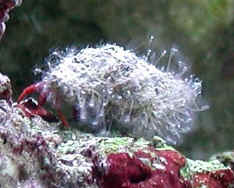
|
Myrionema... Brown Pom-Pom Hydrozoan 11/20/03 I sent you an
email earlier with the wrong picture, sorry. Could you please identify
what is growing with my yellow star polyps. They are more brownish than
the yellow stars and seem to be spreading quickly. Thanks Anjanette
<the organism pictured is unfortunately a nuisance Hydrozoan of the
genus Myrionema. There are no clear predators on this creature to date
that we are aware of... manual extraction is necessary. Also control
nutrient that fuel it (skim well, do small frequent water changes,
careful not to overfeed/overstock. Best regards, Anthony>
Cnidarian ID Myrionema - stinging hydroid 7/18/03 Hi Guys,
<cheers> I have a very strange algae growth in my 50 gal reef
tank (see enclosed pics). I think this stuff came in on some live rock
I bought from a local reefer about a year ago. Now it is starting to
take over my tank. <you have the nuisance hydroid Myrionema from the
Pacific. It can sting and burn corals, clams, etc> I'm wondering
if you know of anything to help me rid my tank of this stuff. <some
limpets eat it> My parameters are: 50 gal reef (no sump) 4 x 96 watt
PC lighting Remora Pro skimmer Approximately 65 - 75 lbs. live rock
Deep Sand Bed 700 gph water movement (power heads) S.G 1.025
(refractometer) Temperature 79-82 F. Calcium 400 - 420 KH 7 pH 8.1 -
8.4 Ammonia/Nitrites 0 Nitrates 0 Water changes/top offs with RO/DI
Thanks for any advice, Brian <some manual extraction may help as
with a tooth brush tied to the end of a running siphon to scrub and
suck the pest out without spreading it. Best regards, Anthony>
Digitate hydroids I have recently set up my first salt tank
and purchased some live rock. I noticed that
there was some strange come out of the
live rock. I did an internet search and have
found out I have at least two Digitate
Hydroids. One completely disappears when the light comes on
the other is about a tenth of an inch long. It is
about three inches long with the lights out the other is
about an inch or two. I have not been able
to find much information on these creatures. I
want to know if they are safe. << Yes, I would keep
them and not worry about them. >> I also need to get a moon light
to see what I am missing. << A flashlight in the middle of the
night comes in handy as well. >> Thanks, Ed
<< Blundell >>
| Many thanks and ID question... First, let me say
"thank you" for myself and all the others you have
helped. I've been reading and absorbing as much as I
can from your site. <Ah, good> Some LR added to my tank has
apparently been "dead rock" for over a month; it was a
very small piece, and I bought it because I had thoughts of adding
some zoos to it later. It has been slowly coming to
life, and recently sprouted a small colony of about 20 little
thingies. They are very tiny (~2-3mm tall) and look like
a small wind turbine -- narrow stalk and four 'arms' in a
cross at the top with small dots at the ends. <I see them...
Hydrozoans of some sort> I've attached a picture, hoping
that you can ID them. My apologies for the focus, but even in macro
mode, they are tough to capture. Thanks again and warm regards,
Matthew <A good enough pic. These can be troublesome creatures
as a group... stinging you and your livestock... but generally they
"cycle out" of their own accord in time. Please read
here: http://www.wetwebmedia.com/hydrozoans.htm and the linked
files (in blue, above) where you lead yourself. Bob Fenner> |
|

|
| Hydroids to Flatworms Hi Guys, I have a cluster of
little brown pom-pom like things in my reef. Using the Google
search on your site, I found out that they are "a fairly
common nuisance hydroid, Myrionema". My question was answered.
<Good> While I was on the Hydrozoans FAQ page I noticed a
posting titled "Stranded Hydroid! Yikes! 4/7/05". Your
staff answered the question and identified the animal as a hydroid.
I had similar things in my tank growing on a finger leather coral.
It turned out to be some kind of flatworm. It had the same
tentacles in the posted picture. The worm would release the
tentacle into the current and pull it back repeatedly. <Strange,
interesting... have not heard of, seen this offered re flatworm
behavior ever> The worms are very clear, so they almost
disappear when they are spread out over the surface of the coral
which makes it seem that the tentacle is coming from the coral
itself. <Good plan, eh?> I used Salifert Flatworm Exit in a
bag of tank water and dipped the coral in it. After approximately
45 minutes the flatworm came off by creating a current in the bag
with my finger. It was a clear, slightly cloudy flatworm. Even
sitting on the bottom of the bag, it released the tentacle and
pulled it back. The tentacle was a long single strand which had
smaller lines coming off one side. I actually got a few of them
using the dip. Each worm only had one strand - so if you see more
than one - chances are that there are several worms. Great Site.
<Thank you for this input. Will try to find the bit you
reference and couple it with yours here> Dave Here was the full
post from the FAQ: Stranded Hydroid! Yikes! 4/7/05 Hello WWM
Crew, <howdy> I have a quick question for you regarding a
finger leather and a strange set of tentacles coming from it.
<yikes! they are not from the leather, but instead are from a
stinging hydroid. They can be quite aggressive to other reef
creatures and even burn your skin painfully> I have attached a
picture of identical tentacles as what are coming from
my leather but am unsure of how to deal with this issue. <manual
removal> I have only had the leather for 3 weeks now and it has
never extended a single polyp. <Perhaps it's irritated from
the hydroid. More importantly... I fear you have added this coral
to your tank without a proper quarantine period. Yikes, if so...
it's a surefire way to introduce pests and predators to your
tank like this hydroid> Every evening these threads come out and
they are very intricate which is what led me to believe they were
not just mucous. I cannot see anything on the leather
itself by following the threads but there are 6 or 7
coming out. Any help you can give me would be greatly appreciated.
Regards, Scott B. <There are many types of hydroids in the
world. Some look like corals... some look like algae... others more
like jellyfish. Caution with all :) Anthony> |
|

|
| Hydroids... Hydrozoan: what's in a name? 6/21/05 Ah,
yes... understood. It really does look like a flatworm. Not so
though. Its a ctenophore... benthic sort of "hydroid" or
"jelly" (not the same, but kin). In the hobby... we have
been calling the thing that I think you are seeing (a unique
description... really sounds like it) "a hydroid" for
lack of a better understanding/term. Pics of one of my own attached
- its being scraped from the underside of a Fungiid. And... a link
to a quick mention of the lil buggers here: http://www.seaslugforum.net/display.cfm?id=12274 Anthony
:) |
|
|

